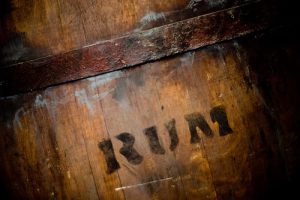A Tip of the Glass to American Whiskey

The distillation of whiskey in this country dates back to the arrival of European farmers, especially those from Ireland and Scotland, who brought with them the skills and knowledge necessary for producing spirits from whatever grains were available. However, beverages produced by these homemade distilleries were for self consumption only and perhaps a few friends and neighbors.
The first known commercial distillery in America was started in 1664 on what today is Staten Island for the production of rum, as it was the preferred drink of the times. Three years later, a distillery was opened in Boston, Massachusetts, and by 1677, rum was Colonial New England's most prosperous industry.
With the advent of the Revolutionary War, British shipping blockades made the importation of Barbados molasses and sugar, key ingredients of rum, almost impossible to get, effectively disrupting America's rum production. This spawned increased interest in whiskey as a spirits substitute, not only by the drinking public, but by the Continental Army as well, as each member was allowed one gill (four-ounces) of spirits per day as part of their rations.
By the end of the Revolutionary War in 1784, American whiskies had became popular--primarily rye whiskey in Pennsylvania and New England and corn whiskey in the south and west--and commercial distilleries were beginning to be established.
 In 1791, Alexander Hamilton, Treasury Secretary for the new government, imposed the first tax on distillers in an effort to recover from the heavy war debts. Fearing it would be extended to include other drinks, foods, even clothing as in England, distillers demanded the tax be repealed. When their demands fell on deaf ears, the 1794 Whiskey Rebellion was organized in protest.
In 1791, Alexander Hamilton, Treasury Secretary for the new government, imposed the first tax on distillers in an effort to recover from the heavy war debts. Fearing it would be extended to include other drinks, foods, even clothing as in England, distillers demanded the tax be repealed. When their demands fell on deaf ears, the 1794 Whiskey Rebellion was organized in protest.
The insurrection, headed by a group calling themselves the "whisky boys," immediately turned violent, assaulting tax collectors, burning their homes and destroying property of those who dared pay the tax. Finally, a federal militia force of thirteen-thousand soldiers commanded by President George Washington restored order. The rebellion leaders were captured, convicted of treason and sentenced to death but later pardoned by Washington.
 Ironically, in 1797, one year after leaving the presidency, Washington and his Mount Vernon overseer, James Anderson, started what would become Virginia's largest distillery. Beginning with two stills, the first year's production was eighty gallons of rye whiskey. The following June, they added five stills located in a new stone building next to the farm's mill, and by 1799, the year of Washington's death, production was almost eleven-thousand gallons. Selling for sixty-cents a gallon, the distillery realized a seventy-five hundred dollar profit.
Ironically, in 1797, one year after leaving the presidency, Washington and his Mount Vernon overseer, James Anderson, started what would become Virginia's largest distillery. Beginning with two stills, the first year's production was eighty gallons of rye whiskey. The following June, they added five stills located in a new stone building next to the farm's mill, and by 1799, the year of Washington's death, production was almost eleven-thousand gallons. Selling for sixty-cents a gallon, the distillery realized a seventy-five hundred dollar profit.
The Mount Vernon distillery continued to operate until 1808, nine years after Washington's death. In 2006, the site was excavated, and the distillery reconstructed on the original foundations. Today, it is the only eighteenth-century working distillery in the nation.
As the nation's demand for whiskey continued to grow, and so did the number of distilleries. By 1810, there were 14,191 registered distilleries in America producing more than 25 million gallons of whiskey per year, almost five times as much as Washington's operation. Many of these operations were located in Tennessee and Kentucky where many of the Irish, Scotts, and Scotch-Irish immigrants had settled and migrated.
The first recorded distillery in eastern Tennessee was constructed in 1771, twenty years before the rebellion, by Evan Shelby, Jr. at Sapling Grove near the Holston river, although there is no record of how long it operated or when it closed. It is known however that East Tennesseans were producing significant quantities of rye whiskey (as was the custom in eastern colonies) by 1785.
Soon afterward, settlers in middle Tennessee--finding the soil well suited for growing corn, oak plentiful for making barrels, smooth limestone-filtered water, and a good network of rivers available for shipping their product--also began constructing distilleries. By 1799 the area boasted sixty-one stills.
 Tennessee's oldest registered distillery still in operation today is Jack Daniel's, located in Lynchburg, south of Nashville and just above the Alabama state line. Ten years later, George Dickel built his distillery on the Highland River between Nashville and Chattanooga.
Tennessee's oldest registered distillery still in operation today is Jack Daniel's, located in Lynchburg, south of Nashville and just above the Alabama state line. Ten years later, George Dickel built his distillery on the Highland River between Nashville and Chattanooga.
The Tennessee distilling industry continued to grow, quickly becoming one of the largest producers of whiskey in the nation, especially Roberson County near the Kentucky border. Unfortunately, an intermediate series of events over the next sixty years would serve to impede that growth.
During the Civil War, Union troops that occupied the area banned the production of spirits in order that the corn and grains be used to feed men and livestock. But with the end of the war, production resumed, and by 1886, Robertson County distillers were producing 45,000 barrels per year, consuming so much corn that large amounts had to be purchased from other parts of the country in order to keep up with whiskey demand.
By the late 1800s, the Women's Christian Temperance movement and other church groups, coupled with intense competition that caused smaller, less successful distillers to close, saw Robertson County's distilling industry (the largest in Tennessee) take a sharp decline. Then by 1909, with only five distilleries left, a statewide prohibition on the manufacturing of whiskey (ten years before the national prohibition) forced these and the other Tennesse distilleries to close or move to other states.
Bourbon County was established in the early 19th century in eastern Kentucky. Named in honor of the Bourbon kings of France who aided America in the Revolutionary War, the area became the center of that state's whiskey production. Over the years, the original area's boundaries have been divided into thirty-four modern counties. Today the County is dry, and the production and sale of spirits prohibited.
Distilleries in Bourbon county used a distinctive method of producing their whiskey known as the "sour mash" style and was labeled as "Bourbon County Whiskey." By 1840, "bourbon" was well recognized as a particularly smooth, amber colored whiskey brought about by aging the spirits in charred oak barrels (prior to this time, whiskey was basically clear in color). This distinctly American technique for making whiskey was soon adopted in other states as well.
 Although not Kentucky's oldest family to produce whiskey, Evan Williams was responsible for the state's first commercial distillery, built in 1783 on the banks of the Ohio River near Louisville. Four years later, the Reverend Elijah Craig opened the Heaven Hill Distillery in Georgetown. One of the last distilleries (now in its seventh generation) was constructed in Kentucky during the 18th century by Jacob Beam (Jim Beam Bourbon) in 1795.
Although not Kentucky's oldest family to produce whiskey, Evan Williams was responsible for the state's first commercial distillery, built in 1783 on the banks of the Ohio River near Louisville. Four years later, the Reverend Elijah Craig opened the Heaven Hill Distillery in Georgetown. One of the last distilleries (now in its seventh generation) was constructed in Kentucky during the 18th century by Jacob Beam (Jim Beam Bourbon) in 1795.
 Other notable post Civil War Kentucky distilleries still in operation include the Ripy Family Distillery built in 1869 (Wild Turkey) and the A. Ph. Stitzel Distillery(Old Fitzgerald) built in 1872. It should also be mentioned
Other notable post Civil War Kentucky distilleries still in operation include the Ripy Family Distillery built in 1869 (Wild Turkey) and the A. Ph. Stitzel Distillery(Old Fitzgerald) built in 1872. It should also be mentioned  that although Old Forester Bourbon, first bottled in 1873 by George Garvin Brown (Brown-Forman Corporation), is one of America's oldest, continuously bottled brands, it was initially blended from whiskey by other distillers.
that although Old Forester Bourbon, first bottled in 1873 by George Garvin Brown (Brown-Forman Corporation), is one of America's oldest, continuously bottled brands, it was initially blended from whiskey by other distillers.
In 1920, the U.S. Congress passed the eighteenth amendment to the Constitution which prohibited the manufacturing and sale of alcohol. This thirteen-year prohibition shut down almost every legal distillery in the country; most never reopened. During this period, only George T. Stagg, Pepper (Old Crow), Stitzel-Weller, and Glenmore distilleries (Yellowstone) were allowed to continue producing whiskey for "medicinal" purposes.
Following the 1933 appeal of prohibition, many of the old distilleries never reopened. Brand consolidations and slow rebuilding saw a resurgence of only ten Kentucky distilleries and two Tennessee operations--Jack Daniel's and Cascade (later becoming George Dickel & Company).
Today, we see whiskey companies reviving many of the old recipes and brand names as they attempt to appeal to America's growing trend toward the super premium niche-brand spirits market. We are also seeing a growing interest in the development of microdistilleries, a movement that, while still in its infancy, is sure to become as popular with the liquor crowd as microbrewing is with beer drinkers.
Some Whiskey Facts:
- American whiskey produced in the United States is made from fermented mash whose production and labeling is governed by Federal Regulations.
- Unless it is blended, the whiskey must be distilled to no more than 160 proof (80% alcohol by volume), the addition of coloring, caramel, and flavoring is prohibited, and except for corn whiskey, must be aged in charred new oak containers.
- American corn whiskey does not have to be aged, but if it is, must be aged in used (normally used bourbon barrels) or uncharred oak barrels.
- Unblended whiskey aged for two years or more may be labeled "straight"--as in "straight bourbon whiskey."
- Only four brands of Tennessee whiskey are currently bottled--Jack Daniel's, George Dickel, Benjamin Prichard's, and Collier and McKeel.
- Tennessee whiskey is defined by some international trade agreements as being Straight Bourbon Whiskey produced in the state of Tennessee, not an official type of whiskey according to U.S. federal regulations.
- Bourbon does not legally have to be produced in Tennessee.
Try Em: Makers Mark Kentucky Straight Bourbon Whiskey, Produced in Loretto, Kentucky by Beam Inc; Woodford Reserve Distillers Select, Produced in Woodford County, Kentucky by Brown-Forman Corporation; Bulleit Bourbon Frontier Whiskey, Produced in Lawrenceburg, Kentucky by Diageo; Black Maple Hill Small Batch, Produced in Bardston, Kentucky by Heaven Hill Distillery; Pappy Van Winkle's Family Reserve, Produced in Frankfort, Kentucky by Sazerac Company
Make Em: Vieux Carré, Jim Beam Fruit Punch, Lynchburg Lemonade, Bourbon Peach Cobbler, Bourbon Pecan Pie, Tennessee Whiskey Pork Chops


